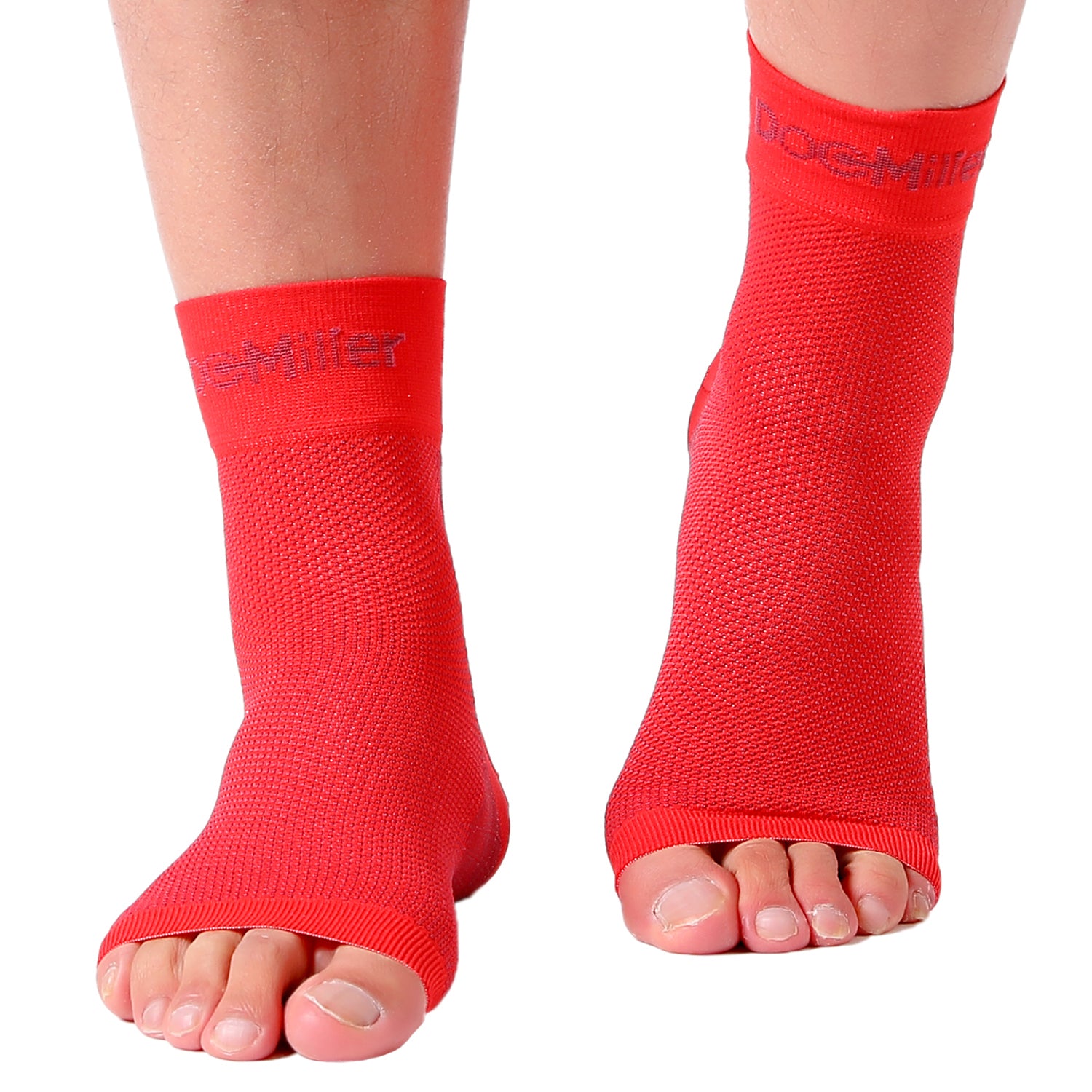A go-to method for treating heel pain is a plantar fasciitis night splint. These splints hold the foot in a position that gently stretches the plantar fascia and the calf muscles while you sleep. This plantar fasciitis brace is lightweight and cool, which makes it the user more comfortable wearing it for extended periods of time, thereby speeding the healing process while easing pain. If you suffer from plantar fasciitis pain first thing in the morning, your doctor may recommend that you wear a special splint or ankle brace while you sleep. The purpose of this type of plantar fasciitis product is to keep the foot extended throughout the night, to reduce stress on the plantar fascia.
This can lead to greater comfort both while you sleep and in the morning. Like insoles, plantar fasciitis night braces and splints are sized. The sizing may run according to shoe size or the physical measurements of the feet. You can read the product descriptions of specific products for more information about sizing.
A plantar fasciitis night splint helps combine these two effective conservative treatment methods–keeping your foot or feet gently flexed in a stretch while you sleep. Plantar fasciitis is a very common problem that affects a part of the foot known as the plantar fascia. This band of tissue runs along the bottom of your foot from the bottoms of your toes to your heel. Its purpose is to strengthen and support the arch of your foot.
When this tissue becomes injured or strained, it develops inflammation, which leads to the pain associated with plantar fasciitis. Before using any type of product to address plantar fasciitis symptoms, it is important to talk to your doctor or health care provider about your concerns. He or she can confirm that you're suffering from plantar fasciitis and recommend the best methods of dealing with your discomfort.
Plantar fasciitis is the term commonly used to refer to heel and arch pain on the bottom of the foot. Overpronation is the most common cause of plantar fasciitis. As the foot rolls inward excessively when walking, it flattens the foot, lengthens the arch, and puts added tension on the plantar fascia. Pain is generally worse in the morning when first getting out of bed or when sitting for prolonged periods. The plantar fascia is a band of tissue that runs from the heel, spans the entire bottom of the foot, and inserts onto the forefoot. The function of the plantar fascia is to support the arch of the foot.
As one walks, the plantar fascia contracts and stretches. Plantar fasciitis is this inflammation of the plantar fascia tissue which occurs mostly at the insertion point on the heel or anywhere along the tissue. These ligaments act as shock absorbers that support the arch of your foot.
However, too much pressure can cause the ligaments to become inflamed—when this occurs, the inflammation often causes heel pain and stiffness. This pain is most often felt when you take your first steps after getting out of bed or after extended periods of inactivity. If you prefer the feel and fit of heel cups in your shoes as opposed to full-length insoles, it's hard to beat Heel That Pain Heel Seats. They are made with an extra-firm gel that provides continuous support for folks who spend hours on their feet each day.
A type of inflammation of the plantar fascia ligament on the bottom of the foot, plantar fasciitis affects approximately 2 million people every year. It can stem from tight calf muscles, flat feet or high arches, weight gain, non-supportive footwear, and more. Dr. Scholl's is a trusted brand that creates insoles and inserts specifically designed for people with plantar fasciitis. Made with a contoured heel cup and special cushioning that absorbs shock, these insoles also help to stabilize the plantar fascia and prevent it from further stretching. The plantar fascia is a thick band of tissue that runs from your heel to your toes that assists with both supporting the arch of your foot and shock absorption.
When this tissue becomes irritated and inflamed due to overuse, plantar fasciitis will develop. This damage to the plantar fascia will cause a stabbing pain in your heel, thus making walking around and other physical activities difficult at times. Plantar fasciitis is one of the most common causes of heel pain and may require the help of our trained Foot Doctor near me to be corrected. High-quality sock night splints are soft, cozy, and stay cool while you sleep. Often, doctors recommend that people dealing with plantar fasciitis take steps to protect and support the soles of their feet during the day.
This is often done through the use of insoles or orthotics that are placed inside of shoes. The insoles provide cushioning and help to reduce stress and strain on the plantar fascia in order to diminish pain. Insoles are typically designed to fit men's or women's shoes and are sized according to standard shoe sizes, making it easy to select the right model for your needs. Before choosing a product for relief from plantar fasciitis, you should consider your specific needs and preferences.
If you only have pain first thing in the morning, you may want a massage or stretching tool to help warm up and loosen the plantar fascia and your calf muscles. For people who are on their feet all day, compression socks and sleeves are convenient and easy to get pain relief. Fitness walkers and runners may want to get insoles that are best suited for active people. The idea is sound , but finding out if it is the right solution for your heel pain can be real cumbersome.
The plantar fascia is a ligament that is long and thin. It is located on the bottom of the foot and helps to create the arch of the foot. The plantar fascia goes from the heel bone, splits, and then goes to the toes. When a patient suffers from plantar fasciitis, it means that there is inflammation present.
The pain will be present at the bottom of the foot and the heel. This condition can occur in both feet at the same time, often because the patient stands for long periods. It is most often seen in active males between the ages of 40 and 70. These insoles are designed with arch support in mind, whether you have flat feet, knee pain, or achilles tendinitis.
They work to correct abnormal walking patterns and balance pressure on your feet by evenly distributing weight. The medical-grade foam in these inserts also deliver maximum shock absorption and stabilizes your arches—and they're ultra-lightweight, too, making them ideal for running. Should flat feet be causing you pain and discomfort, Dr. Muroff can work with you to help mitigate this issue.
He may teach you a variety of stretches to help manage this unfortunate condition. Any stretches you learn can be done from the comfort of your own home! He may also give you custom orthotics to place in your shoes. These orthotics will offer the proper support your feet need when moving around.
Until the inflammation of your feet decreases, Dr. Muroff may require you to wear an ankle brace for additional support. As a high-quality Foot Doctor near me, Dr. Muroff will closely monitor your progress throughout treatment and take all the steps necessary to correct your condition. The right shoe can make a big difference for your foot pain. The best shoes for plantar fasciitis have good arch support, cushioning, shock absorption and a thick heel. If you're an active runner or on your feet often, replace your shoes every 500 miles or when the back cushion of the shoe gets more than 2 creases. Doing so, will allow them to continue to provide the support you need.
With plantar fasciitis, you suffer from chronic pain in the bottom of your heel or the bottom of yourfoot. While it may feel like inflammation, it is associated with a degenerative problem involving the tissue that connects your toes to your heel bone. Plantar fasciitus happens a lot with runners and people who have flat feet, high arches, are overweight, or who are on their feet a lot.
It's the reason you dread getting out of bed in the morning. That first excruciating step out of bed… that feeling of a hot spike being driven through your heel. There is at least one way that has been documented previously by people like yourself and its through the use of a plantar fasciitis night splint. Morning stretches may only do so much for you, but the all night stretch that a splint offers has provided many people the relief they look for. Although most patients with plantar fasciitis respond to nonsurgical treatment, a small percentage of patients may require surgery. If, after several months of nonsurgical treatment, you continue to have heel pain, surgery will be considered.
Your foot and ankle surgeon will discuss the surgical options with you and determine which approach would be most beneficial for you. Cushioning not only helps with pain relief but can also prevent further inflammation and improve foot stability. Support in the arch and ankle area should be firm but flexible. Plantar fasciitis insoles also provide a cushy cup for your heel to relieve pressure.
Together, those features can help make your foot feel more comfortable. Avoid loose, thin-soled shoes, as well as shoes without enough arch support or flexible padding to absorb shock. If you regularly wear high heels over 2 inches your Achilles tendon — which is attached to your heel — can contract and shorten, causing strain on the tissue around your heel.
If your "go to shoe" is over a year old, chances are your foot pain would be lessened with a new pair of new shoes. Wearing the wrong shoe for your foot type can also contribute to heel pain. Instead of prescribing a night splint, Dr. Davidson advises on a stretching regimen. At the two week check up, if the plantar fasciitis has not significantly improved he will adjust the regimen.
Following another check up, Dr. Davidson typically advises on over-the-counter inserts like the Polysorb . And if worst comes to worst then he will prescribe the more expensive yet effective combination of physical therapy and custom orthotics. Your doctor may suggest that you work with a physical therapist on an exercise program that focuses on stretching your calf muscles and plantar fascia. This relaxes the plantar fascia and is one of the reasons for morning heel pain. A night splint stretches the plantar fascia while you sleep. Although it can be difficult to sleep with, a night splint is very effective and does not have to be used once the pain is gone.
In addition, we provide sports medicine care and custom orthotics. As a sports medicine doctor, I have spent many years treating plantar fasciitis in my patients. I recommend many solutions for plantar fasciitis pain, including physical therapy, buying appropriate shoes, and icing. The Vive night brace is your typical plantar fasciitis boot, designed to reduce pain and inflammation first thing in the morning. It comes with a couple foot wedges for better positioning and a foot massaging ball as additional bonuses. This night splint is designed with 3 velcro straps and a soft padding that covers the entire shell, perhaps making it the most comfortable splint on the market.
Our board-certified podiatric foot and ankle specialists and clinical care team provide personalized treatments for foot and ankle disorders, trauma, deformities, diseases and conditions. From common fractures and sprains to problems with the bones in your feet to nail disorders or diabetic foot conditions, you'll find expert care at Ohio State. If your situation is related to physical activity, you may see one of our podiatrists, or an orthopedic surgeon for yourfoot and ankle injury. Relief starts with the right diagnosis and treatment plan.
If you ignore the painful symptoms of plantar fasciitis, you may set yourself up for chronic heel pain that hinders your daily activities. And simply changing the way you walk to relieve your discomfort can lead to future foot, knee, hip, or back problems. These full-length insoles from Sof Sole are approved by the American Podiatric Medical Association Academy and are designed to provide all-day relief from plantar fasciitis.
They feature a reinforced plantar relief bridge, which supports the arch, and a nylon composite plate to help reduce stress on the feet and ankles. The gel heel cup helps with pain relief, while also improving stability and motion control. If you have a normal range of ankle motion and continued heel pain, your doctor may recommend a partial release procedure. During surgery, the plantar fascia ligament is partially cut to relieve tension in the tissue. If you have a large bone spur, it will be removed, as well. Although the surgery can be performed endoscopically, it is more difficult than with an open incision.
In addition, endoscopy has a higher risk of nerve damage. A night splint holds your foot in an optimal position for stretching of the plantar fascia to take place. Your plantar fascia is the ligament that runs along the bottom of your foot. Stretching the plantar fascia helps reduce stress and inflammation in your feet. Many people with plantar fasciitis have intense heel pain in the morning, when they take their first steps after getting out of bed.
This pain comes from the tightening of the plantar fascia that occurs during sleep. Stretching or massaging the plantar fascia before standing up can often reduce heel pain. Wearing a night splint to keep the foot and arch stretched keeps the plantar fascia ligament from contracting and becoming less flexible in the morning. As you have seen, there is plenty of backing that support the benefit of using plantar fasciitis night splints for reducing heel pain, or getting rid of it altogether.
It is one of the protocols that people do have trouble following, but if you feel that it could benefit you there are certainly testimonies that validate its use. We've already reviewed the Strassburg Sock in our plantar fasciitis socks review, but it would be more appropriately listed here. While not having the hard plastic spine of a traditional night splint, this sock's key feature is as a knee-high sock with material from the toe attaching directly to the knee area. This is how they are able to maintain a stretch of the plantar fascia and give results similar to those from the night splints. It is much less cumbersome in general, but has mixed reviews.
When all else fails, we've listed this as another option for you to explore. The Neo G Plantar Fasciitis Everyday Support features Multi Zone Compression to help relieve swelling and discomfort. Advanced Silicone Heel Cushioning helps provide impact protection as well as support and added comfort in every step. The support is used to help relieve Plantar Fasciitis symptoms such as heel and arch pain. Slimline and lightweight design enables the support to be worn in most footwear, making it the perfect solution for daily activities and everyday relief.


























































